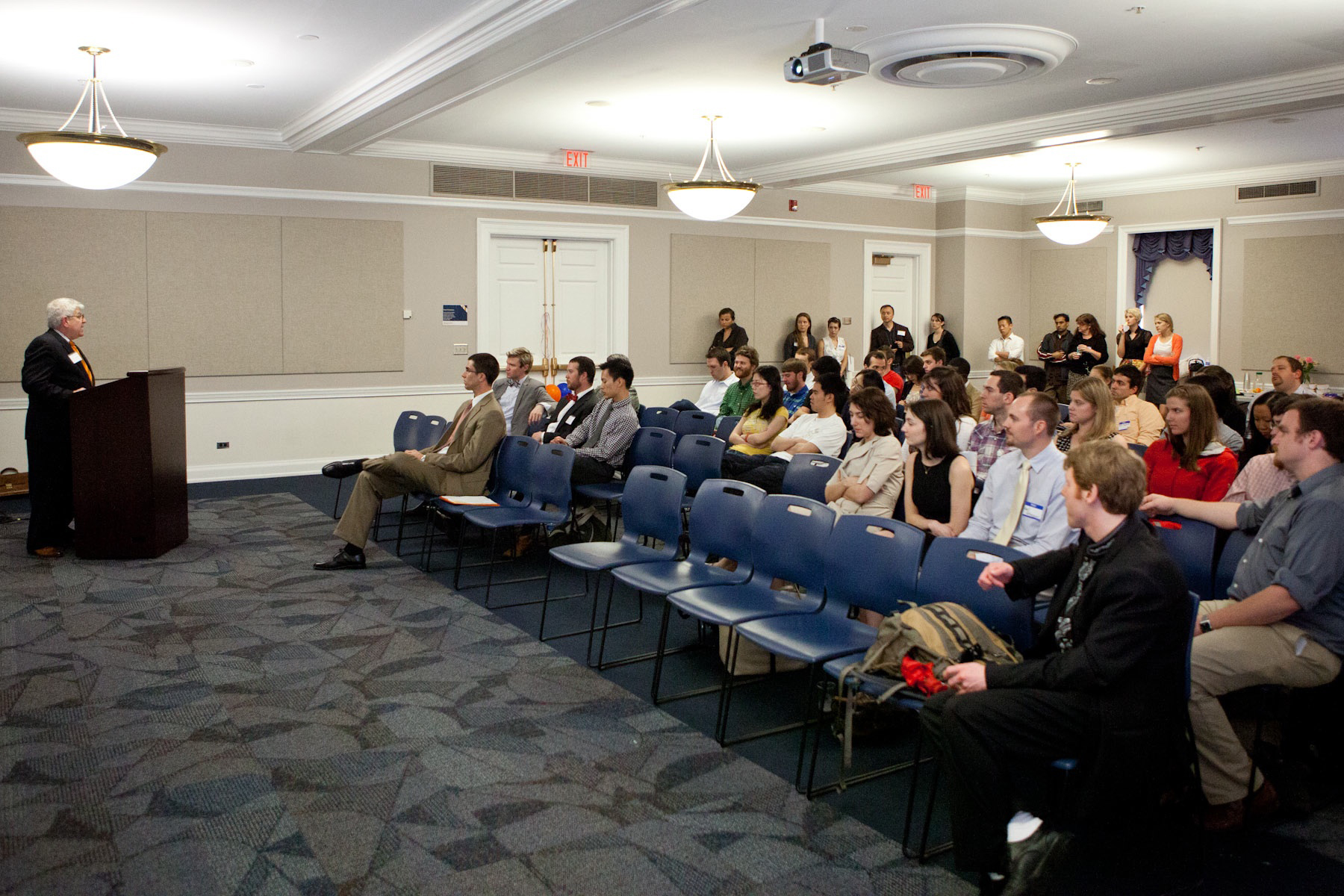March 23, 2012 — Understanding the natural cycles of the world and the inner workings of the human mind were but a few of the fields in which University of Virginia graduate students displayed their research Wednesday.
About 120 researchers participated in the 12th annual Robert J. Huskey Graduate Research Exhibition in Newcomb Hall. Forty-five participants made oral presentations of their work, while the remainder presented poster displays. The exhibit is named after a former biology professor.
The show gave the graduate students an opportunity to hone their presentation skills and think about their research in new ways.
"It helps me to share ideas with people and questions help me move an idea further," said Yishan Xu, a Ph.D. candidate in psychology in the Graduate School of Arts & Sciences researching attitudes in China and the U.S. about cohabitation and marriage.
She found that older Chinese are less accepting of cohabitation than either young Chinese or young Americans. Researching the reactions of older Americans is the next step in her research. She found that while young people from both countries have similar attitudes toward cohabitation in areas such as love and money, the Chinese subjects were more concerned with having a Chinese partner, while the American subjects were more concerned with lifelong commitment.
"Older Chinese feel that well-behaved young people should not have intimate behavior without marriage," she said, adding that her curiosity was sparked by her parents' reaction to her marrying a non-Chinese and her own reluctance to cohabitate before marriage.
Siny Tsang, a second-year psychology graduate student, studied relationships of a different sort, examining how a romantic partner influences delinquent behavior in teen-agers. "It's a negative influence," she said, adding that she plans to pursue further research.
Kelly Hondula, who is in the third year of her masters' program in environmental sciences, said the exhibition was important to be able to explain her research.
"This helps me take out the jargon for someone who is in a different field," she said.
Hondula, who is researching the feeding habits of clams on Virginia's Eastern Shore, said that her work may have long-term implications to the economy of that region, where harvesting clams is a major industry. Through her research, she hopes to be able to determine if clams can survive on natural forage, or if clammers need to augment the bivalve's diet.
"A benefit of this exhibition is that there is a general audience, so they are talking to people who do not have the technical expertise they do," said Michael Schreck, a graduate student in economics and one of the exhibition's organizers. "It also promotes an interdisciplinary dialogue, which is something the University has encouraged."
"This is the première showcase of graduate research, with a wide variety of disciplines represented," he added. "Much of the audience is other graduate students and faculty, with some undergraduates."
Grace Wilkinson, a Ph.D. candidate in environmental sciences, is studying organic material in lakes in Michigan and Wisconsin, tracking carbon as it moves through the ecosystem.
"I grew up in Minnesota, the Land of 10,000 Lakes, and I have always been interested in what goes on under the water," she said.
Riana Elyse Anderson, a doctoral student in psychology studying ethnic identity and perceptions of discrimination, tracks how parents who have experienced racial discrimination may socialize their children to expect similar treatment, but with positive messages and a supportive community, the next generation may not look at difficulties as being racially motivated.
"I'm from Detroit and I am looking for anything that can explain successful outcomes," she said.
Anderson credits her mother for her own successful outcome. "A mother's positive messages to me, a lot of community support – this helps children," she said.
The Huskey exhibit was one of several events planned for GradDays, a celebration of graduate and professional student life and academic achievement at U.Va., highlighting the graduate and professional community.
There were nine first-place winners in oral presentations: Noel Derecki, neuroscience; Kimberly Cox, neuroscience; Cristina Reitz-Krueger, psychology; Izzie Green, chemistry; Jamie Allison, history; Kayce Kuss Tayler, psychology; Evan Joslin, chemistry; David Dobolyi, psychology; and Stacy Gorski, microbiology.
There were 12 first-place winners in the poster presentations: Eric Smith, psychology; Carol Brotherton, nursing; Stesha Dunker, environmental sciences; Alex Zestos, chemistry; Tony Awoojodu, biomedical engineering; Ramya Viswanathan, biochemistry; Siny Tsang, psychology; Thomas Talhein, psychology; Jill Greiner, environmental sciences; Olivia Mullins, neuroscience; Jennifer Kaplan, pathology; and Marc Seaman, biomedical engineering.
Charles Sparkman placed first in the architecture competition and Gail Zasowski of the Department of Astronomy and Karen Hamm, a double major in astronomy and physics in the College of Arts & Sciences placed first in the "Two Hoos" competition, for research that pairs graduate students with undergraduates.
There were seven second-place finishers and seven third-place finishers in the oral presentations and 12 second-place finishers and nine third-place finishers in the poster presentation.
In all, about $8,000 in prizes were presented, with 48 faculty members volunteering as judges for the daylong event. The prize money was provided by the Office of the Dean of the Graduate School of Arts & Sciences and the Office of the Vice President for Research and Graduate Studies. The School of Architecture provided the money for the architecture award and the Center for Undergraduate Excellence funded the Two Hoos award.
– by Matt Kelly
Media Contact
Article Information
March 23, 2012
/content/minute-vast-uva-grad-students-present-research

